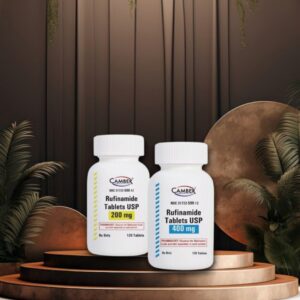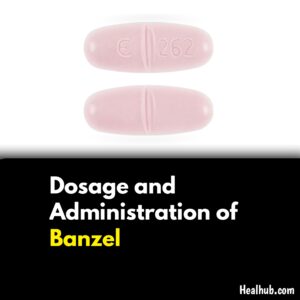Banzel Comprehensive Guide
Banzel, otherwise known by its generic name rufinamide, is used to treat a type of epilepsy called Lennox-Gastaut Syndrome (LGS) and that other symptoms.
In this blog, we discuss how Banzel came into being and the history of it along with its components, benefits as well as side effects on Patients.
In addition to examining one of the most commonly prescribed drugs for Dravet Syndrome, this all-encompassing resource offers a look into Banzel that any highly motivated member of clinical development, patient or care giver would be interested in.
Introduction

Regular, recurring seizures characterize epilepsy, an affliction of the nervous system. Despite the numerous kinds, LGS is specifically treacherous and has really particular medical demands. In addition, Banzel (brand name for rufinamide) have been a crucial therapy in the treatment of this condition and has provided assurances to manypatients and their families.
Typically, LGS develops first in youth. It is linked to various seizure types, mental decline, and resistance to conventional antiepileptic medications. Patients with LGS now have an additional option for reducing the intensity and recurrence of their seizures, which improves their level of satisfaction. This is due to the departure of Banzel.
History and Development
Banzel’s journey from creative work to commercial support serves as evidence of the complex processes necessary to familiarize patients with an advanced medication.
Rufinamide was OTSUK-002 when still held by Novartis Drugs and then later on acquired by Eisai Co., Ltd. a Japanese pharmaceutical company renown for developing drugs in the fields of neurology, oncology and gastroenterology (the only one) to name just some therapeutic areas from their portfolio.
In 2008, the US Food and Drug Administration (FDA) approved the use of banzel as an additional treatment for seizures related to Lennox-Gastaut condition in patients who were 4 years of age or older. This approval signified a significant accomplishment as it opened up another treatment option for a disease that had shown to be notoriously difficult to manage.
Related Drugs
Uses of Banzel

Based on the main purpose of using medication as a kind of treatment for seizures associated with (associated to) Lennox-Gastaut syndrome, the emphasis is upon seizure control as a whole rather than an isolated part. The intention of adjunctive treatment in LGS is that the concentration be focused on only a few cycles of the beginning (front-end) seizure. As with adjunctive therapy,an even more comprehensive approach to this complex problem becomes apparent.
Rufinamide is found most useful in treating LGS but its trial studies are being performed that whether this drug can also help for more seizure disorders. Although its usage has not been approved and is under clinical examination in situations like the focal epilepsy along with Dravet syndrome, several studies are advised regarding applying this for procedure of these disorders.
Clinical Trials and Efficacy
Their solid clinical trials offered the basis for Banzel’s approval. One seminal study,114 with 138 patients with LGS randomized to either placebo or rufinamide. The rufinamide group showed much less seizure frequency when compared to the placebo group, results revealed. The median percent reduction in total seizure frequency was 32.7% with rufinamide vs 11.7% for placebo, the researchers reported.
Later studies supported similar conclusions, demonstrating that rufinamide enhanced patients’ and their families’ overall quality of life in addition to lowering the frequency of seizures. Studies with long-term follow-up have shown that Banzel is a useful alternative for the long-term therapy of LGS due to its persistent efficacy and tolerability.
Dosage and Administration of Banzel

2 BANZEL is dosed individually based on the patient’s age, weight and response to treatment. Typically, the dose is initiated in divided doses (10 mg/kg/day) for pediatric patients 4 years and older. This may be increased gradually to a maximum of 45 mg/kg/day depending on patient response and tolerance.
Adults are usually given an initial dose of 400 -800 mg/day (tablets or suspension) in two divided doses. This is titratable up to 3200 mg/day [LIMITED DATA] Given that everyone reacts to a drug differently, BUT be sure to meticulously follow the directions YOU are GIVEN by the prescribing physician.
Banzel is sold as tablets, which need to be taken whole with water. It can be taken either way, although taking it with meals may lessen any adverse effects on the gastrointestinal tract.
Side Effects of Banzel
Banzel has the same possible side effects as any medicine. The most typical side effects consist of:
- feeling dizzy
- Feeling tired
- vomiting
- giving up
- Headache
- Sleepiness
Even though these side effects are usually minor and temporary, more severe negative reactions could happen. Among them are:
- reduction in the QT interval, a cardiac rhythm measurement
- severe allergy responses
- Hypersensitivity reactions involving many organs
It is important to keep an eye out for any indications of severe side effects in patients and to report any alarming signs right away to a healthcare professional. Regular follow-ups are also necessary to evaluate the drug’s efficacy and modify the dosage as necessary.
Before taking Banzel
In order to make sure the safe and efficient use of Banzel (Rufinamide), it is important that patients and caregivers understand a number of key components of the drug before starting. The following are important things to remember:
1. Medical History and Consultation
Seizure History: Give a thorough account of the kind, frequency, and intensity of the patient’s seizures.
Prior Medical Interventions:Discuss about all anti epileptic drugs (AEDs) used previously and currently, along with their efficacy including any type of adverse events or side effects.
Additional Health Issues:Inform the physician if you are already suffering from other illness like mental health disease, liver problems or heart conditions.
2. Allergy and Sensitivity Check
Allergic Reactions
Sensitivity History: Inform the specialist if you have ever experienced any adverse drug reactions, particularly to antiepileptic medications.
Overly sensitive Responses: Talk about any past experiences with drug-induced rashes or multi-organ high sensitivity reactions, as these can be quite dangerous when using Banzel.
3. Understanding Banzel’s Use and Effects
Tool for the Task
How It Works: Understand that Banzel reduces the frequency of seizures by activating dormant sodium channels in the brain.
Effects that are probably incidental
Common After Effects: Be aware of common side effects, such as fatigue, sluggishness, retching, nausea, and disorientation.
Significant Repercussions: Recognize the signs of potentially harmful side effects, such as decreased heart rate, severe adverse reactions, and touchiness in multiple organs. If they occur, prompt clinical evaluation is essential.
FAQs
Is BANZEL a narcotic?
Banzel is certainly not a controlled substance however a doctor prescribed medication that is utilized close by different drugs to control seizures. It is reachable from most drug stores with no extraordinary conditions.
How much does BANZEL treatment cost?
The expense for Banzel oral suspension (40 mg/mL) is around $1,862 for a stock of 460 milliliters, dependent upon the drug store you visit.
How old is BANZEL?
Published Date: November 17, 2008; Banzel (rufinamide) Approved for Severe Epilepsy
Eisai Re-submits NDA for Rufinamide (a Counter-Epilepsy drug) -11/18/05
Sep. 13, 2005Eisai applies for a new medication from the FDA to combat epilepsy using rufinamide.
When was BANZEL approved by the FDA?
Status: Approved on 2008-11-14 A
What type of seizures does BANZEL treat?
BANZEL is shown for adjunctive treatment of seizures related with Lennox-Gastaut Condition (LGS) in pediatric patients 1 year old enough and more seasoned, and in grown-ups.